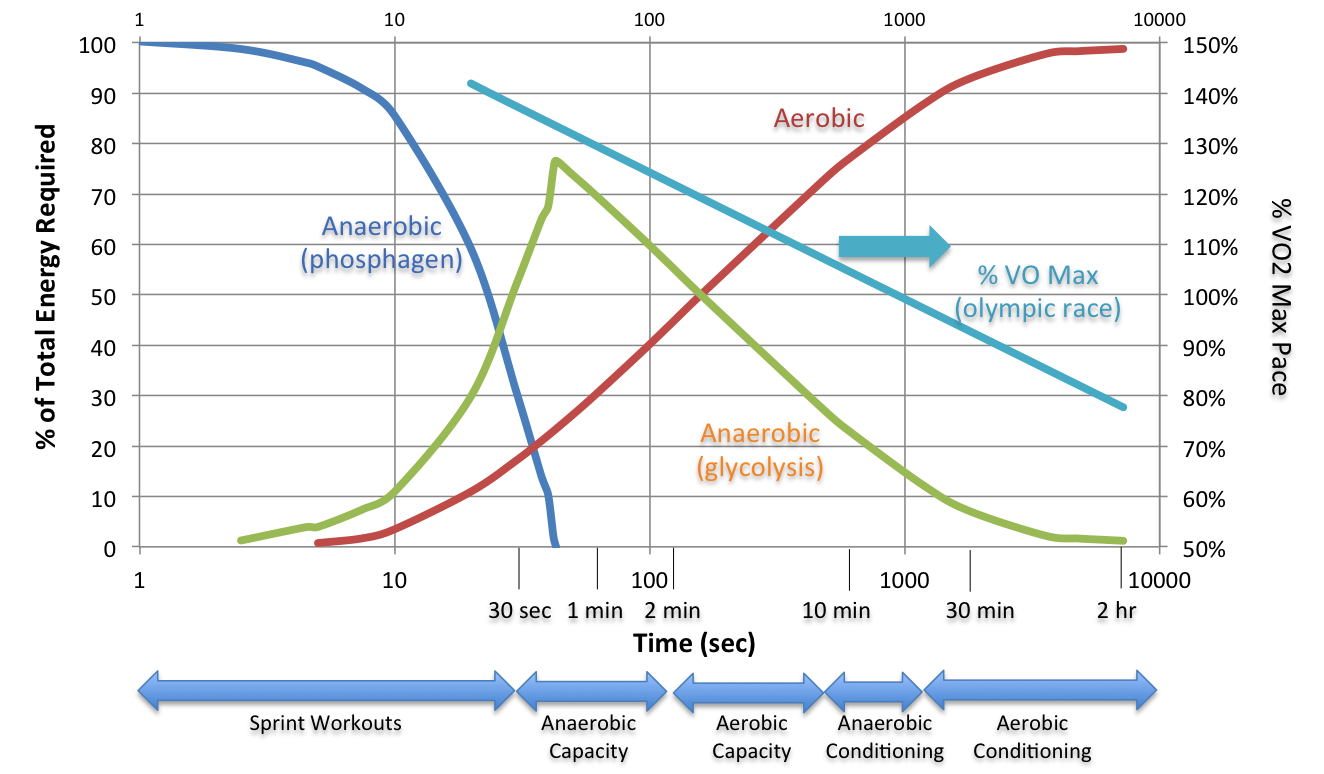- Home
- About Us
- Mobile Applications
- Support
- Contact Us
The human body has three primary or major energy systems that produce the necessary ATP (adenosine triphosphate: the body’s energy source) to enable the muscles to perform work. These are:
The first two systems use anaerobic type reactions, which means they do not rely on external (breathing) oxygen to supply energy to the muscles. The last system uses oxygen, so it is an aerobic type reaction.
Anaerobic Systems
The Phosphagen system is capable of producing high energy in a short period of time (explosive energy). It is used during the starting phase of any quick movement, such as the start of a sprint, early phase of lifting a weight, etc. However, the availability (or storage) of this energy is fairly low, it only lasts for about 10 sec before its levels start to drop very quickly (see the chart below). But, the recovery can also be fairly quick, about 30 to 60 sec. after finishing the exercise.
The second component of the anaerobic system produces ATP using glycolysis at a lower rate than the Phosphagen system. It starts to produce energy shortly after the Phosphagen system has kicked in (about 2 to 3 sec). In a 200m sprint, once the stores of ATP in the Phosphagen system are depleted, the Glycolytic system becomes the primary source of energy, reaching a peak close to 42 to 45 sec (see the chart below).
The Glycolysis are several enzymatic reactions, where the glycogen (stored glucose or carbohydrates in the muscle) breakdown to form molecules of lactic acid or pyruvic acid (this outcome depends on other metabolic factors), hydrogen and ATP. The hydrogen is used by the aerobic energy system, and any hydrogen that is not used reacts with pyruvic acid to form lactic acid.
One of the drawbacks of this system is that it produces lactic acid, which is one of the primary substances that cause muscle fatigue. As more lactic acid is formed, the areas surrounding the muscle cells become acidic. Eventually the acid would break down the muscle. That is why we have muscle fatigue that prevents the lactic acid to continuing forming in our muscles. Also, the accumulation of lactic acid inhibits glycolysis and energy production
Because of the lactic acid buildup, the anaerobic energy systems can be used between 30 sec to 2 min, depending on the intensity of the exercise and fitness level, which in essence relates to the body’s capability of its rate of neutralization (buffering) of the lactic acid.
Aerobic System
The aerobic system produces energy at a much slower rate than the anaerobic systems. However, is the main body's mechanism to produce energy when sustaining efforts past 20 min (see the chart below). Aerobic ATP production (Oxidative Phosphoralation) goes on in the mitochondria of the cells and involves two metabolic pathways known as the:
The primary role of the Krebs cycle is to complete the oxidation of carbohydrates, fats, and proteins. During this cycle, the hydrogen is removed reacting with oxygen to form water. Also, the hydrogen energy can be used in the ETC to form ATP. The oxygen permits accepting the hydrogen molecules at the end of the ETC. This is why it is imperative to have oxygen.
Without oxygen all these metabolic processes back up and as we said when the hydrogen’s get backed up they react with pyruvic acid to form lactic acid. Then an accumulation of lactic acid inhibits glycolysis and energy production.
These reactions reduce significantly the accumulation of lactic acid around the cell muscles, allowing the body to perform the exercise for longer periods of time. Some of the carbon dioxide production comes from buffering the lactic acid.
Maximum Effort and Energy Systems
The amount of time one can sustain a given effort is inversely proportional to the effort's magnitude, i.e. low intensity efforts can be sustained for longer time periods than higher intensity efforts. The following chart shows the relative energy contribution of the different body systems when sustaining a maximal running effort for a given period of time. This chart varies from individual to individual, depending on the athlete's fitness, genetics and other factors. However, it serves to have a better understanding on how the body's energy is used when performing activities at maximal effort and its application to training concepts.

In the chart, one can see that after about 10 sec of maximal effort, the energy contribution (or share) of the phosphagen system drops very quickly, and past 40 sec, its contribution is almost negligible. it is interesting to notice that by the time the phosphagen system is depleted, the glycolysis system reaches its peak, which occurs near 42 to 45 sec. At approximately 2:30 min of effort, the aerobic and anaerobic systems contribute close to equal amounts of energy. Then, the anaerobic energy contribution continues to drop, and somewhere past 20 min its share drops below 10% of the energy requirement. Thus, after 20 min most of the energy is generated aerobically.
The chart also has a line that show aproximately the % of V̇O2 max pace (inthe right scale) that is used in race events, such as the olympic games. For example the 3km race with a 7:21 time, is run at a pace of about 105% of V̇O2 max pace.
The diagram also shows the training times four the primary training zones and sprint workouts which are discussed in more detail in the pages on Training Concepts and “Training Zones”.
Also, you can find more information and data on these subjects in the book by David E. Martin, et.al. "Training Distance Runners" [1] and the following web sites:
Section One Wrestling
Sport Fitness Advisor
The next section discusses the concept of maximal oxygen uptake and lactic threshold.